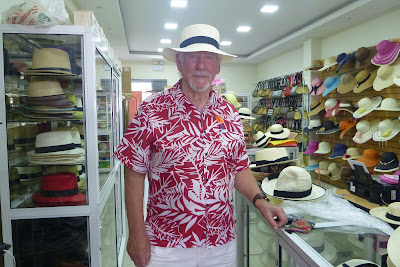Manta, Ecuador
84F
(29C) Day 50 on the
cruise
We
were supposed to have a stop at Guayaquil but were told by the Ship that the
water levels for our ship were too low to make port. Bummer, we already had an excursion
booked in Guayaquil so now we are 2 days in Manta instead.
The
trip we had booked in Guayaquil was to a hat factory.
So what is the big deal with this ‘hat’? Ah, ever since I was small and read a story about the famous Panama Hat I wanted one. Oh, it’s not just a hat. It’s a Panama Hat. No, they are not made in Panama, they are made in Ecuador. Panama Hats became ‘famous’ because in about 1910 or so, then U.S. President Teddy Roosevelt wore this hat when he visited Panama. It’s not just a hat; it’s an emblem, an heirloom, a status symbol, an icon. The real deal hat is hand woven. It takes up to eight months to make just one hat. It’s made from a plant fiber.
The best quality
hats are known as Montecristis,
after the town of Montecristi, where they are
produced. The rarest and most expensive Panama Hats are hand-woven with up to
3000 weaves per square inch. In February 2014, Simon Espinal, an Ecuadorian
47-year-old Panama hat weaver considered to be among the best at his craft, set
a world record by creating a Panama hat with four thousand weaves per inch that
took eight months to handcraft from beginning to end.”
According to popular
lore, a "superfino" Panama Hat can hold water, and, when rolled up,
pass through a wedding ring.
 |
| Looking for the perfect Hat |
So
how do you choose one of those Hats? The price ranges, the variety of finished
products in Manta, I guess anywhere in this region, are broad. There are many,
many sellers. The ship’s bus tour we took to Montecristi dropped us of at a Hat
Market, a section of the city set up just for tourists like us. The guide who
was on the bus with us educated us during the trip from the Ship to the Market.
She had samples of Hats and told us what to look for. We saw some ‘production’
of how the Panama Hats are made, but it was more a demonstration of hat making than
a sales pitch. What a workout this is, to weave one of those Hats. The weaver
is bent over a post all day and it is pure handwork.
 |
| Weaver at the Store Where Hans Bought His Hat |
The weaving position to
make a Hat is a must to get the shape of it just right. There is no better or
other way to make the Panama Hat. It is an amazing feat of human ingenuity and
dedication to make just one Hat. The fibers the weavers use are hair like, cut
down to size by hand. All of the materials used on the Hat, except the
decorative bands at the end, are natural fibers from the Toquilla Plant.
This
is a 10 minute video, but it is very interesting to see how a Hat is made.
 |
| Hans' Hat Being Trimmed |
So
how did I buy this hat? Our guide told me to see a seller who has a store
in town, she told me he is one of the best in Montecristi. I listened to her
since I saw she was not being paid to say that, so I trusted her judgment.
I went to:
Modesto Hat, (this web site does not always work), Calle 9 de Julio y Olmedo, Montecristi , Ecuador.
 |
| Great Hat Hans. |
And I bought a ‘superfino’ hat. It had to be trimmed and banded and that took some time, but I love this Hat. It feels as light as a feather. Carol also got a Panama Hat but hers was very different, a more ‘open weave’ kind of hat, and it was not superfino.
 |
| Carol's Hat Is Like One of These |
While my Hat was being ‘processed’ Carol went to take pictures of the church nearby, wearing her ‘new’ Panama Hat with a smile.
 |
| Statue On the Edge of Town |
 |
| Tagua Nuts In Various Stages of Drying In the Sun |
 |
| Not Yet Dry Tagua Nut |
Today, while the use of true ivory is banned worldwide, the use of Tagua is encouraged. When I compared chess pieces made from Tagua for example, there was a hardly discernible difference between the 2 materials. Buy Tagua, it’s economical, renewable and organic.
 |
| Tagua Ivory Inside the Nut |
 |
| Painted Beads From Tagua Nut |
 |
| The Ones That Fell Were Quickly Snapped Up By the Workers |
 |
| Look What I Found |
Manta is a major port for Ecuador. A shipping port for tuna fish, both blue fin and yellow fin tuna. Ecuador also exports shrimp, bananas and cacao. The cacao grown here has special appeal to Switzerland and Belgian chocolates. It is said that cocoa has different flavors, depending on what grows next to the plants that produce the cacao nuts.
Ecuador
has many climates: beaches, highlands, Amazon like jungles and the famous
Galapagos Islands that are totally unique on earth.
David Pengelly, a ukulele player was our evening entertainer. Really, he was not bad at all.
On
a sad note, Stephen Hawkins passed away today, he was 75. RIP

